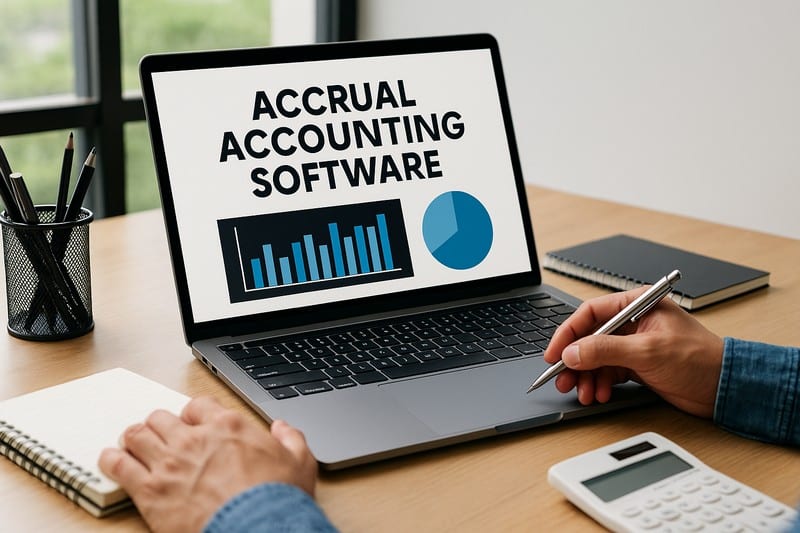Running a residential contracting business isn’t just about pouring concrete and laying tile—it’s about keeping the entire operation on solid financial footing. And for many contractors, the key to understanding whether they’re truly profitable isn’t hidden in the next project bid—it’s hidden in their accounting method.
If you own a contractor business, chances are you’ve heard of accrual accounting. Maybe your bookkeeper mentioned it, or your CPA recommended switching from cash accounting. But for many small business owners, especially those in trades, the word “accrual” sounds like something out of a finance textbook rather than a practical tool.
Yet in truth, accrual accounting is one of the most powerful ways to understand your company’s real financial health. It helps you match your income and expenses to the time period in which they actually occur, giving you a much clearer picture of how your projects perform—and whether your business is truly growing or just staying busy.
Let’s break down how to properly account for accruals as a contractor working on residential homes, what pitfalls to avoid, and how this approach can help you build a business that’s as structurally sound as the homes you construct.
Why Contractors Need Accrual Accounting
Contracting is a different animal from most small businesses. You don’t make a sale and collect payment in the same moment. Projects stretch over weeks or months. You might buy materials, pay subcontractors, and rent equipment long before you send out an invoice.
Cash accounting—recording income when you receive money and expenses when you pay them—can make your books look deceptively healthy or dangerously poor depending on timing. For example, you might show big profits in one month after receiving payments for several jobs but forget that you still owe suppliers and subcontractors. Or, you might show a loss in a month where you’ve paid for materials and labor upfront, even though you’ll invoice the homeowner next month and collect your profit then.
Accrual accounting fixes this mismatch by recording revenues when they’re earned and expenses when they’re incurred—not when cash changes hands. For contractors, that means recognizing the value of the work you’ve done, even if you haven’t been paid yet, and recognizing your costs as they occur, even if you haven’t cut the check yet.
How Accrual Accounting Works for Contractors
Let’s say your company, Copper Ridge Construction, starts a $60,000 home renovation in April that will take three months to complete. You spend $20,000 on materials and labor in April, another $25,000 in May, and the rest in June. You bill the homeowner $30,000 in May and $30,000 in June.
If you use cash accounting, your books would show: April: a $20,000 loss (all expenses, no income); May: $5,000 profit ($30,000 income, $25,000 expenses); and June: $30,000 profit (income recorded, minimal new expenses). That looks chaotic—and misleading. You’re not losing money in April or making a windfall in June; you’re just completing one steady project.
Under accrual accounting, you record both revenue and expenses when they’re earned or incurred, which gives a more accurate reflection of performance. April: $20,000 revenue earned, $20,000 expenses—break-even. May: $25,000 revenue, $25,000 expenses—break-even. June: $15,000 revenue, $15,000 expenses—break-even. Now your financials tell the real story: you steadily earned income and covered your costs over the course of the project.

The Essentials of Properly Recording Accruals
Implementing accrual accounting might sound intimidating, but once you understand the basic categories, it becomes second nature.
Accounts Receivable (AR)
This represents money owed to you for work you’ve already completed or billed. If you finish framing a house in June but don’t get paid until July, you still record that June income as accounts receivable. Keeping your AR ledger current ensures you know exactly how much money is pending and helps prevent forgotten invoices or payment disputes.
Accounts Payable (AP)
On the flip side, AP tracks your outstanding bills—money you owe suppliers, subcontractors, and service providers. When you receive a supplier invoice in May for materials used that month, record it as an expense in May, even if you won’t pay it until June. This gives you a clearer picture of your liabilities and helps you manage cash flow more effectively.
Accrued Liabilities
These are expenses you’ve incurred but haven’t been billed for yet—like unpaid wages, utilities, or project costs that haven’t been invoiced by a subcontractor. For example, if your electrician finished wiring in June but hasn’t submitted his invoice yet, you’d still record the estimated cost as an accrued liability.
Work in Progress (WIP)
This one is big for contractors. WIP tracks ongoing projects—essentially the value of the work you’ve completed but not yet billed. It’s a crucial tool for measuring progress and profitability on long-term contracts. By keeping tabs on WIP, you can identify whether projects are ahead or behind financially. A project might look profitable at the end, but if costs are running high mid-way, WIP tracking gives you early warnings before it’s too late.
Using Accrual Accounting Software to Simplify the Process
One of the smartest moves a contractor can make is to use accrual software built with construction businesses in mind. Tools like QuickBooks Online Advanced, Xero, Buildertrend, or Sage 100 Contractor allow you to automate much of the tedious work—tracking invoices, calculating accounts payable and receivable, and updating work-in-progress balances without endless spreadsheets. These platforms can generate real-time financial reports that show which projects are profitable, where your money is tied up, and which clients owe you payments. The right software doesn’t just save time—it reduces costly errors and ensures your numbers stay accurate from project start to finish. When used properly, accrual accounting software becomes your virtual bookkeeper, giving you clarity and control while freeing up hours you can spend where it matters most: on the job site.
Making Accruals Work Day to Day
The key to successfully managing accruals as a contractor is consistency. It’s not enough to switch your accounting method; you need systems that keep it running smoothly.
Use construction accounting software that supports accrual-based reporting (like QuickBooks Online Advanced, Buildertrend, or Jobber). Reconcile monthly: check that your AR, AP, and WIP align with project timelines and invoices. Communicate with your bookkeeper—make sure they understand construction cycles—billing, retainage, milestone payments, etc.—so your financials truly reflect reality. Keep job costs separate: track expenses per project rather than dumping all costs into a single expense category.
Once these processes are baked into your routine, accrual accounting starts working for you, giving insights that help you manage cash flow, forecast revenue, and make smarter business decisions.
Common Mistakes Contractors Make with Accruals
Even with good intentions, contractors often trip up on a few recurring problems when implementing accrual accounting.
Failing to record revenue until payment arrives—this turns accrual accounting back into cash accounting and distorts performance. Overlooking accrued liabilities—not tracking unpaid bills can make your profit look inflated. Ignoring project retainage—if a client withholds 10% of payment until final inspection, account for that properly. It’s not lost income; it’s deferred revenue. Not reconciling regularly—errors compound quickly if your accruals aren’t reviewed monthly. Mixing personal and business expenses—a classic small-business mistake that becomes even messier under accrual accounting.
Avoiding these pitfalls keeps your books accurate and protects you come tax season or audit time.
The Benefits Beyond Compliance
For contractors, accrual accounting isn’t just about bookkeeping—it’s about visibility and strategy. Accurate job costing: you’ll know which projects are truly profitable and which ones are draining resources. Better cash flow forecasting: you’ll anticipate when income is due and when major bills hit. Smarter tax planning: since accrual accounting smooths out fluctuations, it helps you plan for consistent taxable income. Stronger relationships with lenders and investors: financial statements built on accrual principles look more professional and reliable.
The biggest payoff, though, is peace of mind. You’ll stop feeling blindsided by sudden “profit swings” that are really just timing differences.
Balancing Accrual Accuracy with Cash Awareness
There’s a catch—accrual accounting doesn’t mean ignoring cash flow. In fact, cash is still king. A contractor can show profit on paper while running out of money in the bank. The trick is learning to balance both perspectives.
Keep separate but connected dashboards: one for accrual-based profitability and another for cash flow tracking. Monitor when invoices are due, when payments are expected, and what your upcoming expenses look like. It’s not uncommon for contractors to have months where they’re “profitable” but cash-poor—awareness prevents that from becoming a crisis.
When to Bring in Professional Help
Accrual accounting can get complex fast, especially if you juggle multiple projects with staggered billing cycles. Hiring a CPA or bookkeeper who specializes in construction accounting is one of the best investments you can make.
These professionals can help you set up your chart of accounts tailored to construction, calculate and monitor WIP and retainage accurately, prepare accrual-adjusted financial statements, and plan quarterly taxes based on realistic income projections. Think of them as your financial project managers—they keep your books structurally sound so you can focus on the job site.
Final Thoughts: Building Financial Strength Brick by Brick
Accrual accounting may sound like a small technical change, but for a contractor, it can completely transform how you understand your business. By matching income and expenses to when they actually occur, you build a clearer, steadier picture of performance—and make smarter decisions about growth, hiring, and cash management.
At the end of the day, your books are just another kind of blueprint. When done right, accrual accounting gives you the foundation to build not just great homes, but a great business—one that’s ready for the long haul, stable through every season, and built on numbers you can trust.








